Myanmar - Burma Travel Journal: Mandalay
| This travel journal is part of a series of journals, which are all written during a long trip between november 2007 and may 2009. |
> Temples in Mandalay
28-02-2009 After the terribly bumpy journey over here, in a much too old and cramped bus and with our first flat tire of the entire trip, we haven't done much more than resting and updating our website during our first two days in Mandalay. We still can't imagine that Robby Williams dedicated
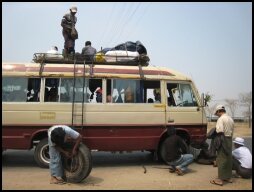 an entire song to the "Road to Mandalay". It hás to be he got here by airplane, not having the foggiest idea about road conditions, or he must be nuts.
an entire song to the "Road to Mandalay". It hás to be he got here by airplane, not having the foggiest idea about road conditions, or he must be nuts.This morning we went to see some sights for the first time, walking to Mandalay Hill, where a colorful assembly of temples and monasteries is built upon and around. Especially Shwenandaw Kyaung, completely made of teak, is worth a visit, with all its woodcarving.
01-03-2009 We cycle to Shwe In Bin Kyaung, a monastery in the South-west of the city, situated in a quarter where hundreds of monks are living. Indeed we see red-brown robes everywhere, when we reach the right district, after a ride over unpaved, bumpy roads. The monastery is beautifully situated by a stream and is, once more, entirely made of wood, but unfortunately it hasn't been maintained too well. A thick layer of dust is covering the wood carving inside and outside many of the figures are hardly recognizable, as the rain has worn them off. We walk around a bit, but the monks obviously don't want any contact and we wonder how much this has to do with the sanctions after last years demonstrations.
We hop back on our bikes and in the umptieth unpaved street we are thankful to have such a thick sadles. On the South side we cycle out of the city, to Amarapura, where we check out the world's longest teak bridge, measuring almost a kilometer in length. The surrounding landscape of the bridge is wonderful and rural, the state of decay and ugly concrete restoration work of the site are slightly less charming. Monks and villagers are walking from monatery to temple and from school to village, connected by the bridge over the water. We too cross to the other side, sometimes strongly swaying back and forth. After a late lunch in the vicinity we cycle back to the city.
02-03-2009 Since the market is usually the best place to see local people doing their thing we first go to the lively "produce market", a bit further in our neighbourhood. On this market, all kinds of fresh stuff is on sale and the diversity of products is huge. Yesterday we cycled through several unpaved streets, but here it's really a huge sandpit. And this is Myanmar's second city with about a million residents. We buy ourselves a nice papaya, which we eat in our room and then we go find ourselves a taxi to take us to Sagaing. Of course we don't go to the always present taxi mafia that hangs around in front of our hotel, but we walk a block further to the honest guys.

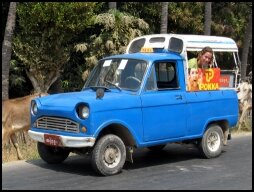
> Sagaing
A little later we're bouncing out of the city in the back of a "blue taxi" from a guy who didn't double the fare. The landscape is arid, but stil so pretty, with all its big, ancient trees with meters thick trunks. An hour later we arrive at the first temple and since we rented the taxi for the day we lazily let the driver take us all the way to each site. The second temple is supposed to be a cave temple, decorated with old rock paintings, but after the initial search to get there we encounter a closed gate. The young monk, still a child, gestures the key to the cave is somewhere in the village and in our taxi he disappears to go get it. Unfortunately, when they return a bit later they do so without the key: on Mondays the cave is closed, so we understand from the hand gestrures. Sure, it's probably just the head monk's day at the local "Rum-station".
Somewhat disappointed we leave, to take a look in a nunnery. As one of the elder, pink clad nuns sees us
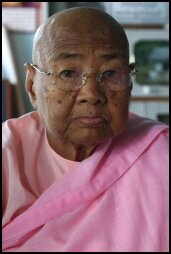 a number of other nuns are immediately summoned and together they recite a song. Also the oldest nun, no less than ninety years old, is collected. She's a teacher to the younger nuns and has spent her whole life in this nunnery. The old, pink crone asks to pose for a photo and then a few of the younger girls, who speak a few words of English, are showing us around.
a number of other nuns are immediately summoned and together they recite a song. Also the oldest nun, no less than ninety years old, is collected. She's a teacher to the younger nuns and has spent her whole life in this nunnery. The old, pink crone asks to pose for a photo and then a few of the younger girls, who speak a few words of English, are showing us around.Halfway through the afternoon we take our chances to climb to the highest stupa, when we meet mister Quick. Mister Quick is a monk, who, according to himself, is the quickest one to climb the stairs to the top. He's a nice guy and when he hears the cave temple is closed today, he takes us to another, unknown temple, which also has some cave paintings. In poor English he tells us the stories of the images. After we visited the highest stupa together after all, we say goodbye to this monk, who told us about the Burmese government and the protest marches of last spring with tears in his eyes.
We like our quiet, non-English-speaking driver and we arrange another day with him tomorrow.
> Paleik and Inwa
03-03-2009 It's nine thirty sharp when we depart and once again we're headed out of the city on the South side. After the rat temple in Deshnok, India, we now take chances to visit a
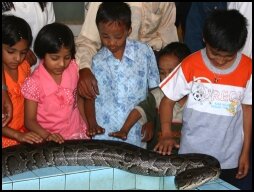 snake temple. In Paleik the Buddhists honour two pythons, the largest measures about four meters and is already thirty two years old. Each day at eleven there's a ceremony where the snakes take a bath and are fed. Pilgrims can also pose for photos with one of the two snakes, after paying the necessary donation of course.
snake temple. In Paleik the Buddhists honour two pythons, the largest measures about four meters and is already thirty two years old. Each day at eleven there's a ceremony where the snakes take a bath and are fed. Pilgrims can also pose for photos with one of the two snakes, after paying the necessary donation of course.After the ceremony we'd like to go to Inwa, but our driver first shows us an entire park with a colection of no less than a hundred new and old stupas. According to him it's a "present", a free extra sight in our tour. It's a remarkable collection at just a small surface and to be honest we appreciate this place even more than Bagan.
Then we take tiny road through rice paddies and fields to the former capital Inwa. From time to time there are little villages of thatch houses and also some nomadic settlements, whith lodgings constructed of palm leaves. When we see one of those settlements fairly close to the road we ask our driver to halt for a while and we go check the place out from up close. These people are cattlemen and move from one place to the next to feed their cows. The troughs are handmade from hollowed-out logs, poo is dried in front of the huts to use for cooking and truly everything they own is handmade. The women and children are openly interested in our visit and the men secretly love our attention too. The digital camera, on which you can see yourself on the backside, is still a queer instrument here and we enjoy ourselves a while with it.
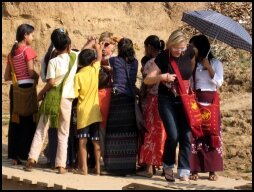 Inwa is an island and when we get to the pont, for the crossing, we're being besieged by children trying to sell beads and postcards. The rental of horse carts on the other side is a real tourist trap as well, leaving us no other option than paying too much, but well... for four Dollars we can hardly complain about that. So now we're in a horse cart, which takes us to the three main sights. We're not all that impressed, by both the temples and the panoramas on the way over there, but it's just another relaxing afternoon.
Inwa is an island and when we get to the pont, for the crossing, we're being besieged by children trying to sell beads and postcards. The rental of horse carts on the other side is a real tourist trap as well, leaving us no other option than paying too much, but well... for four Dollars we can hardly complain about that. So now we're in a horse cart, which takes us to the three main sights. We're not all that impressed, by both the temples and the panoramas on the way over there, but it's just another relaxing afternoon.Due to the road quality and the hardness from the seat of our transport during the past two days we're glad to be back in Mandalay. We go for another nice diner at our favourite streetstall and then we call it a day.
04-03-2009 It's already in the afternoon when we go out, to visit the museum. We'd better saved us the energy, since there's another powercut and the building is too dark to properly see the exhibited items. Would the lights be on, we'd be able to see that there's a dust layer of at least a year on each showcase and it's almost impossible to see anyhing at all through the glass. The pathetic guestbook shows there has only been one other visitor this week. Soon we're back on the street.
At night we walk all the way to the other side of the city to see a puppet show and this really IS worth the energy. The puppets are handmade and look amazing and the puppeteers are truly skilled. The entire show is accompanied by live muziek on traditional instruments. Unfortunately the audience only consists of two other people, so we give them an extra loud applause.
> Mingun
05-03-2009 By boat we sail the Ayeyarwady river, to Mingun, a collection of stupas and monasteries. The largest stupa has never been completed, but with its current fifty meters it's already huge and visible from far.
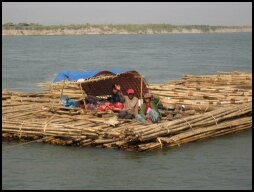
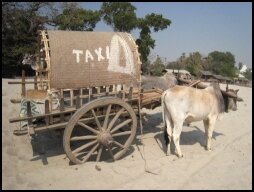
On our way back we once again see the life on and along the river passing by. People are transporting a diversity of goods by boat and large quantities of logs are taken downstream for sale. People are fishing in tiny boats and on the shore thatch huts have been constructed right on the waterfront.
> The Bus to Hsipaw
06-03-2009 Like real Burmese we wake up at sunrise. That's not a voluntary choice, but we'd like to catch the bus to Hsipaw and they told us to be at the office for departure at six fourtyfive. Right on time we're there, but only after seven we can detect some activity and we may sit down on one of the benches in the back of a small truck. Like this we're headed to the bus station, along with about a dozen of other people. And there we find the most prehistorical bus we ever saw. Completely packed with boxes, bags, crates and cans.
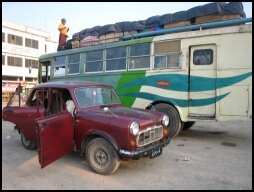 On the roof there's a little space left for our backpacks and the seats in the bus have been detached to weld them on an elevated standard, so there's enough room to store boxes below them. Over a pile of bags which are, as we soon smell, filled with dried fish, we crawl to our seats. We squeeze ourselves in those three square centimeres which we are entrusted, with Peter almost touching his own nose with his knees. Soon we discover our window has no more clasps to keep it open, not exactly what you'd wish for with temperatures rising to fourty degrees in the afternoons. The back of the seat from Yvonnes front neighbour is broken, so it comes back straight away, as soon as she sits down. We're glad to find the worldtravelers-kit for developing countries right there in the street and witha piece of plastic functioning as a rope we fix the window and between that window and the beack of the seat we stick a piece of wood. Now we can sit almost normal, if our heads were not almost
On the roof there's a little space left for our backpacks and the seats in the bus have been detached to weld them on an elevated standard, so there's enough room to store boxes below them. Over a pile of bags which are, as we soon smell, filled with dried fish, we crawl to our seats. We squeeze ourselves in those three square centimeres which we are entrusted, with Peter almost touching his own nose with his knees. Soon we discover our window has no more clasps to keep it open, not exactly what you'd wish for with temperatures rising to fourty degrees in the afternoons. The back of the seat from Yvonnes front neighbour is broken, so it comes back straight away, as soon as she sits down. We're glad to find the worldtravelers-kit for developing countries right there in the street and witha piece of plastic functioning as a rope we fix the window and between that window and the beack of the seat we stick a piece of wood. Now we can sit almost normal, if our heads were not almost 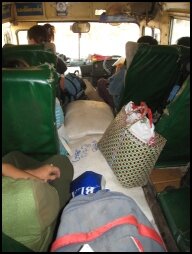 touching the ceiling on our elevated seats and we our legs we can not even move for a single millimeter.
touching the ceiling on our elevated seats and we our legs we can not even move for a single millimeter.Soon after departure we have to admit this bus isn't driving all that bad after all. Suspension is even pretty good and the motor is strong. It has to be, since we're climbing a fair bit, more than thousand meters. The landscape is getting greener and from time to time we see colourful flowers. We stop for lunch at a restaurant where they have strawberries for sale.
After some five hours we're in a village where almost all of our luggage is taken from the roof and even from the bus itself. This leaves us with a little more leg space and allows the driver to hit the accelerator, without all the extra weight. By the end of the afternoon we reach the quiet Hsipaw, where our reserved room is waiting for us. We have diner with some fellow travelers and go to bed early.
> Peace in Hsipaw
07-03-2009 Since markets are at their busiest in the mornings we first go take a look there. Unfortunately the market of Hsipaw happens to be a sleepy one and there are only a few people. We don't stay long and buy some food and drinks before we walk out of the village. We pass hills and cross streams, along green fields and banana plantations to a high waterfall. We can walk all the way to the waterfall and the little pond below and since it's already noon when we get there we have lunch in the shadow by the endless stream of water.
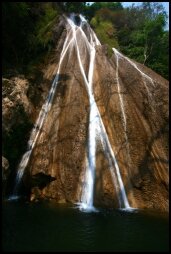 The way back is long, hot and difficult and by mid-afternoon we crash in our room. We spend the rest of the day reading and we only leave our room for diner.
The way back is long, hot and difficult and by mid-afternoon we crash in our room. We spend the rest of the day reading and we only leave our room for diner.
08-03-2009 On foot we discover the Northern part of Hsipaw, which turns out to be a large village with many old and newer temples and stupas. In between the people are living a simple lives in their bamboo huts.
In the afternoon we walk out of the village on the other side and we climb the hill of the nine Buddhas, with a small monastery on top. After the short, but steep climb we're rewarded with an amazing panorama of Hsipaw and the Dokhtawady rivir. A lonely monk serves us tea.
Like it happens all the time in rural areas like this, in the evening and at night the barking of dogs is alternated with the crowing of cocks, and we don't get much sleep before we have to get up at five for the bus back to Mandalay.
> Back to Mandalay
09-03-2009 That bus turns out to be exactly the same one that took us here, only now there's no luggage on the roof and even inside the bus it's still surprisingly spacious. Our seats are the two front seats, so this time we can even see where we're going. While descending to Mandalay the temperature is rising and we're glad when we're there around noon. What a heat... hard to imagine that temperatures are even higher next month.
When visiting our regular internet cafe, after a few days without any connection to the outside world, we're pleasantly surprised. Like true celebrities we are welcomed by two Dutch faces behind one of the screens: "Thát's Peter and Yvonne, from Treelo" Mariëlle shouts. We don't know her and Mark, but they've been checking out our website several times, and since a few months they've started traveling themselves and they recognize us from the photos. Such a coincidence! By the end of the afternoon we go for a drink together and at night we have diner at our favourite streetstall for the last time, before catching the nightbus back to Yangon tomorrow. From there we return to Bangkok, becoming a recurring destination in our journey, before flying to Caďro on the sixteenth.
Mandalay Puppetshow Myanmar videoThe Mandalay Puppetshow Myanmar video will show here |
Paleik Snake Pagoda Myanmar videoThe Paleik Snake Pagoda Myanmar video will show here |
Click on the films up here to look around in Mandalay and Paleik, almost live.
> More Info
Also check our Myanmar info page, where you can find a lot of information about Myanmar and come see our Mandalay photos.